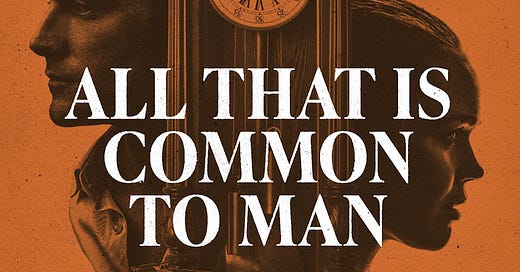I’m looking for new ways to measure my writing process. There’s the standard tried and true methods like word and page counts. Or maybe writing streaks, where I track how many days in a row I can get. But I’m thinking about others as well. Cups of coffee consumed. Paces taken. Miles walked. Sentences re-worked. New ideas generated.
I’m especially interested in the miles walked metric. I wonder what the average distance is per book? Like, what if I knew how far along my book was based on how many miles I’d put behind me?
I better lace up.
Spoilers Ahead for All That Is Common To Man…
We’re nearly there.
This last line may be one of the more obscure Easter Eggs, but I felt it was important to let the last line of the book be the final reference to seven. Seven words, seven dots. And the final of the seven deadly sins.
Wrath.
In some ways, this is more Rachel’s story than Nathan’s. She goes through a more drastic transformation. Her character is the one driving the story forward. It’s Rachel that’s causing the chaos. It’s Rachel that’s destroying everything, and everyone, in her path. Including herself.
I had a reader say to me, “I had to think about the ending.” I think what they were getting at was something like, “I had to think about the timeline.”
Rachel isn’t a typical ghost in the sense that she was once a person, died, and is stuck in her spirit form for the rest of time. There’s a definitive beginning, middle, and an undetermined end point on that type of timeline. For Rachel, imagine the beginning and end of the timeline keep moving further and further away from each other. I thought of this as something like eternity. My editor thought of it more like time-travel. I say, think about it however you like. What’s important is to know that Rachel is afraid of herself as a child, even if she doesn’t recognize what she fears. She’s the one that’s tormented her ancestors. She’s the force that causes madness. And in that sense, she contributes to her own demise. If Rachel causes the madness that infects Thurman Manor, she’s also an active player in this Rube Goldberg Murder Machine.
She has a right to be angry. But if it were justice she was after, I think this would be a very different story. But being wrath, she’s not after justice, is she? Rachel wants destruction, an outlet for unbridled rage, without regard for those who get hurt in the process. And she takes it to an extreme when she takes “pre-revenge” on anyone and everyone she encounters.
At one point, my wife asked me if Rachel could somehow reconnect with Nathan, or if there was a way to show that she still loved him.
I told her no.
I wasn’t trying to be difficult. It wasn’t that I didn’t value her input. My wife was an incredible sounding board through the entire writing process. I understand what my wife was asking, but there couldn’t be a moment of love as they met in the ending scenes. Wrath leaves no room for it. It’s all consuming. It wants annihilation. Wrath, in a pure sense, wouldn’t take a pause from inflicting pain. The wrathful person lets the ones they love suffer as long as they can inflict damage on their enemy. Wrath doesn’t see things clearly. It’s the adage, blinded by rage. And I needed Rachel to be rage personified, represented by fire and malice and unrestricted violence.
No matter who was in the way.
Hiram




